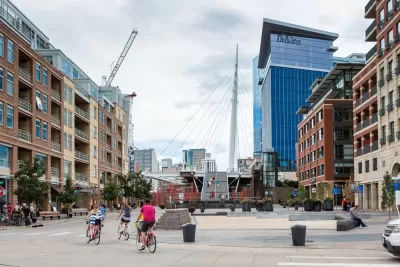As Denver booms, planners and architects discuss the good and the bad of imposing design guidelines on new construction.

While planners have traditionally used zoning requirements to limit the size, location and layout of new projects, it has been far more difficult to find a sensible way to manage the architectural appearance of development. Ray Mark Rinaldi of The Denver Post reports on the fine line planners and city officials are trying to walk between regulating architectural design and throttling creativity.
…in Denver, where the construction boom is on and the consensus is that a lot of buildings are going up that disrespect the character of their surroundings and harm the city's image as a capital of progressive, Western living. Ugly might be hard to define, but there is widespread agreement that it's on the rise.
As new construction has popped up around Denver, the city is looking to find a way to encourage better architectural design from developers. Currently, only about 15 percent of the city is covered by some form of design review advisory board. But is an expansion of design review boards what the city needs?
Denver designer and builder Mickey Zeppelin sees the benefit and the need for design guidelines to give developers some predictability as they go through the process. However, he argues there needs to be some allowance for creativity within the guidelines. Denver planner Nore Winter, who is working with cities around the country to beef up their design standards, believes that effective design review requires not only predictability, but also competent professionals to conduct the review.
Governments and boards have to work within reasonable time frames in approving projects, so construction — which brings jobs and housing and tax revenue — isn't unduly interrupted. Review must take place at the various stages of design, from concept to permitting documents, so there are no money-losing surprises.
And possibly most important, review boards or planning staffs have to be qualified. Panels should be made up of architects, city workers and neighborhood representatives, but they have to know something about design and accept that neighborhoods will grow and change, and that taste varies.
FULL STORY: Denver architecture: Would design rules create a better-looking city?

Planetizen Federal Action Tracker
A weekly monitor of how Trump’s orders and actions are impacting planners and planning in America.

Vehicle-related Deaths Drop 29% in Richmond, VA
The seventh year of the city's Vision Zero strategy also cut the number of people killed in alcohol-related crashes by half.

As Trump Phases Out FEMA, Is It Time to Flee the Floodplains?
With less federal funding available for disaster relief efforts, the need to relocate at-risk communities is more urgent than ever.

Data: In Rural America, Mobile Homes are Heat Traps
Extreme heat is often viewed as an urban problem, but rural communities face their own unique risks.

NYC: What Mamdani’s Rivals Can Teach Him About Transportation
The mayoral candidate won on a bold, progressive platform. Some of his opponents had even bolder ideas.

Berkeley Approves ‘Middle Housing’ Ordinance
The city that invented single-family zoning is finally reckoning with its history of exclusion.
Urban Design for Planners 1: Software Tools
This six-course series explores essential urban design concepts using open source software and equips planners with the tools they need to participate fully in the urban design process.
Planning for Universal Design
Learn the tools for implementing Universal Design in planning regulations.
Heyer Gruel & Associates PA
JM Goldson LLC
Custer County Colorado
City of Camden Redevelopment Agency
City of Astoria
Transportation Research & Education Center (TREC) at Portland State University
Camden Redevelopment Agency
City of Claremont
Municipality of Princeton (NJ)


























